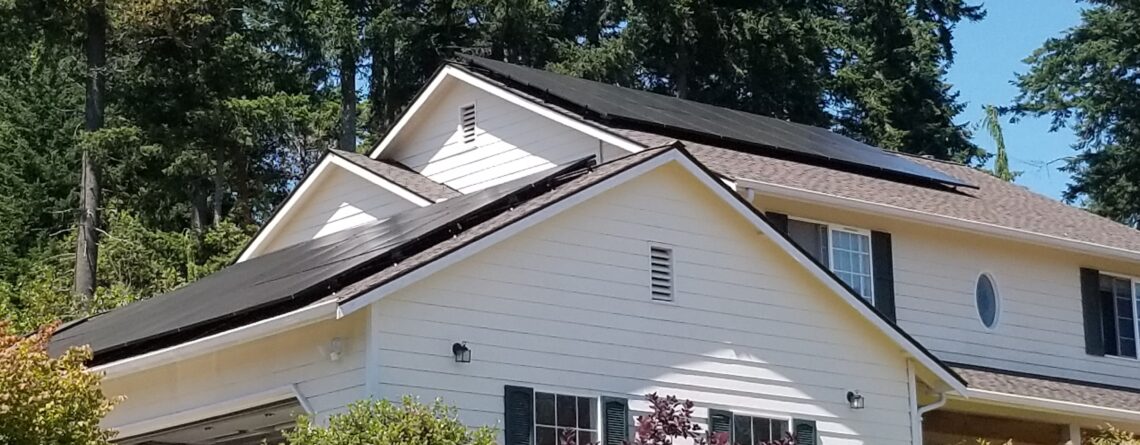How to Size a Grid Tie Solar System Part 2
In How to Size a Grid Tie Solar System Part 1, we showed you a simple way to get a ballpark idea of how many watts of solar panels you need to cover 100% of your electrical usage. That preliminary estimate assumed the each solar panel put out it’s full nameplate rated wattage at all times. Which they don’t. In Part 2 we teach you how to get more precise with your calculations by taking into account factors that impact the real world output of a solar electric system.
Accurately Sizing a Grid Tie Solar System
Have the following information handy. Part 1 explains where to find numbers 1 and 2 below:
- Your average daily electrical use in kilowatt hours (kWh)
- The average sun hours in your area.
- The angle your solar panels will be installed at. For roof mount systems this is typically determined by your roof pitch.
- What direction the solar panels will be facing in relation to the sun. This is known as the azimuth.
- A realistic derating factor. No solar system is 100% efficient. The equipment uses a small amount of electricity while it’s operating, and a minor amount of power is lost as electricity travels through wire. These inefficiencies need to be included in estimates of solar system production. This is called derating. A common derating factor for residential and commercial solar is 0.8.
Now you’re ready to calculate, which may appear complicated, and it can be. Fortunately, our friends at the U.S. National Renewable Energy Laboratory (NREL) provide some help in the form of their PVWatts Calculator.
Using the PVWatts Calculator
Have the following information handy:
- Annual Energy Usage in Kilowatt Hours (kwh)
- Roof Pitch
- Different roof angles drastically affect the production of energy on the solar panels so roof pitch is important when calculating system production.
- Roof Azimuth
- Roof azimuth refers to the direction of solar panels in relation to the sun – basically which direction they are facing: South, West, East, SW, etc. Azimuth can also dramatically affect the production of energy by the solar panels.
- Zip Code
- The physical location of a site also impacts the production of energy on the solar panels.
For practice, use the information below:

Go to the PVWatts website here.
!. Enter in the zip code and press Go:

2. On the Solar Resource Data page click Go to system info.

3. On the “System Info” screen enter the requested data.
- DC System Size (kW) = Daily kWh consumption divided by average peak sun hours.
- For our example, 42.63 kWh/3.5 = 12 kW system
- Module Type = Always “Standard”
- Array Type = It will either be “Fixed Roof Mount” for pitched roof mounted applications, or “Fixed Open Rack” for all ground mounted solar array applications.
- System Losses (%) = Always leave at default for grid tie systems.
- Tilt (deg) = Roof Pitch
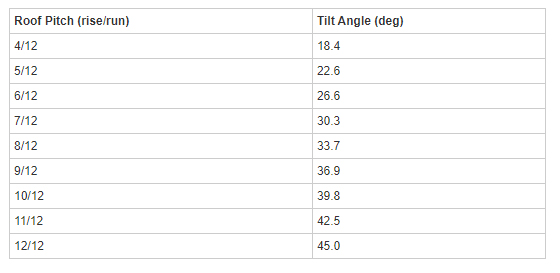
- Azimuth Angle (deg) =
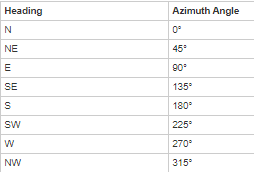
- Do not enter any Advanced Parameters.
Click the blue circle “i” for an explanation about the requested information.
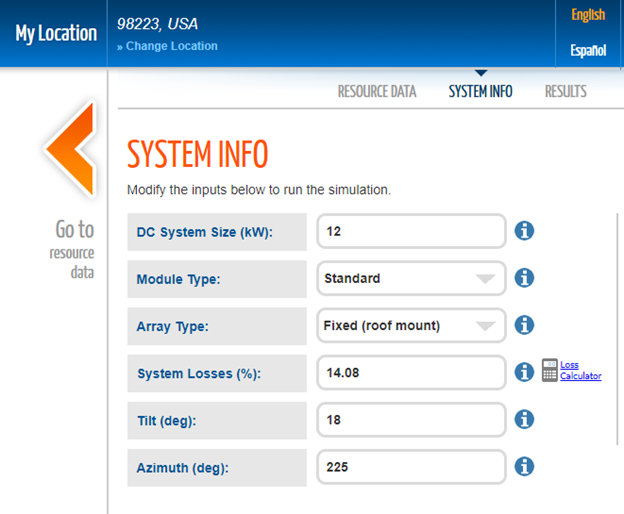
- After all the required information is entered, click “Go to PV Watts results.”

The results state that given the specific site details entered, a 12kW system will, on average, produce 11,364 kWh each year. As you can see, the estimated production of this system is less than the annual power consumption of 15,559 kilowatt hours. Which means we now need to adjust the system size to account for the effects of derating, roof tilt and azimuth.
- Total annual power consumption: 15,559kWh
- Divide the annual power consumption by the estimated production of the 12 kW system: 15,559kWh/11,364 kW = 1.37
- Multiply 12kW x 1.37 = 16.44 kW, rounded to 16.5kW.
Use PVWatts with this size of array (16.5 kW) to calculate estimated system production.
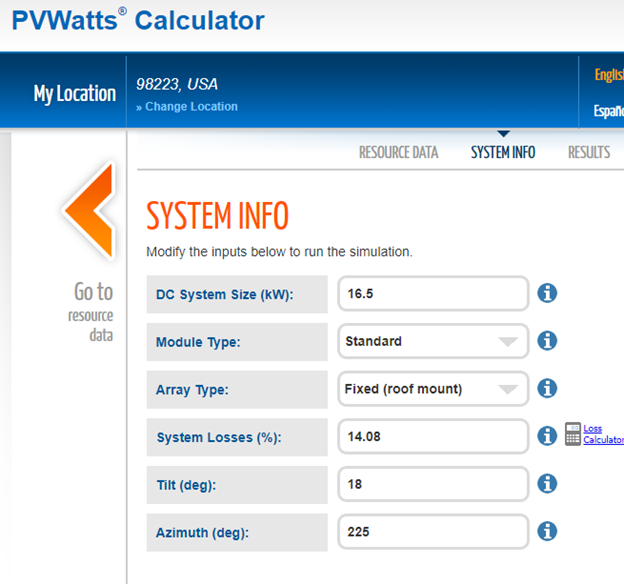

15,625kWh estimated production/15,559kWh average annual power use = 100.4% offset estimated
Now you have a better idea of the size of grid tie solar system that will be appropriate for your household if you want to offset 100% of your electrical use. But, to finalize the system size there are some additional considerations to take into account.
Adjusting for Constraints
Roof Space
The unfortunate reality is that many homes do not have sufficient roof space for a solar system that offsets 100% of a homes annual electrical use. Remember, you cannot use any north, northeast or northwest facing surfaces, since they do not receive any direct sunlight. And some roofs are multi-faceted, or have dormers, chimneys and roof vents that affect the number of solar panels that can be installed. Also, your local code requirements for setbacks and walkways may impact the square footage available for solar panels.
To adjust for these, detailed measurements of your roof space are needed to determine the actual usable space for solar panels. From there you will need to know the dimensions and wattage of the solar panels available to you to determine how many kilowatts of solar will really fit on your roof.
Now you know the optimal size of solar system for your home (100% power use offset), and how many solar panels can fit on your roof. With this information you can do the math to see what percentage of your electrical use should actually be offset with a grid tie solar system.
Which brings us to what is usually the ultimate consideration when you go solar: How much do you want to invest?
Budget
Knowing how many solar panels will fit on your roof means you can finally get a realistic idea of how much a grid tie solar system will cost for your specific household. If the actual cost of solar exceeds your budget for the project, the system size can be reduced accordingly.
Why not just start with your budget? Because knowing how much solar you actually need means you can figure out what percentage of use solar will offset, which allows for important calculations like return on investment.
Sizing Solar for New Construction and Newly Purchased Homes
If you are building a new house or if you haven’t been in your home for a year, you won’t have the historical electrical use data needed to calculate how much of your power bill you can offset. In these cases, we start with available roof space then adjust for budget. Then over time you will observe how much of your power use is covered by your solar system.
Grid Tie Solar Sizing Experts
Whether you need help sizing your grid tie solar system, or you know how much you need and want a DIY or full service installation quote, our experienced team is ready to help you achieve your solar goals.

